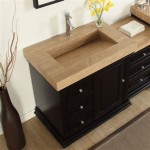48 Inch Farm Style Bathroom Vanity: A Comprehensive Guide
The 48-inch farm style bathroom vanity presents a popular choice for homeowners seeking to infuse their bathrooms with a rustic, yet functional, aesthetic. These vanities, characterized by their Shaker-inspired doors, apron fronts, and distressed finishes, offer a significant amount of storage and countertop space without overwhelming the room. This article will explore the aspects of choosing a 48-inch farm style bathroom vanity, focusing on design elements, material considerations, installation factors, and maintenance tips.
Design Elements and Aesthetic Considerations
Farm style vanities are defined by several key design elements that contribute to their overall charm and functionality. One of the most prominent features is the Shaker-style door and drawer fronts. These are typically characterized by a simple, recessed panel design, offering a clean and timeless appearance. The apron front, which extends slightly below the cabinet doors, adds a traditional touch and provides a visual break in the cabinetry. Distressed finishes, such as antique white, weathered gray, or natural wood with visible grain, are also common, enhancing the rustic appeal of the vanity.
Hardware plays a crucial role in completing the farm style look. Consider using cup pulls or bin pulls for drawers and simple knobs or bar pulls for doors. Matte black, oil-rubbed bronze, and brushed nickel are popular hardware finishes that complement the rustic aesthetic. The countertop material significantly affects the overall style and functionality of the vanity. Common choices include granite, quartz, marble, and butcher block. Granite and quartz offer durability and resistance to staining, while marble provides a luxurious and elegant look. Butcher block adds warmth and a natural touch to the vanity, though it requires regular maintenance to prevent water damage.
The design of the sink and faucet also contributes to the overall aesthetic. Undermount sinks are a popular choice, creating a seamless countertop surface and making cleaning easier. Vessel sinks, which sit on top of the countertop, can add a more dramatic and contemporary touch to the farm style vanity. Faucet styles that complement the farm style aesthetic include bridge faucets, widespread faucets with cross handles, and gooseneck faucets with a vintage-inspired design. Finishes such as oil-rubbed bronze, brushed nickel, and matte black are commonly used.
Beyond specific design features, it is important to consider the overall color palette of the bathroom when selecting a farm style vanity. Neutral colors, such as whites, creams, grays, and muted blues, are commonly used in farm style bathrooms, creating a calming and inviting atmosphere. The vanity can either blend in with the existing color scheme or serve as a focal point, depending on the desired effect. For example, a dark gray vanity can create a dramatic contrast against white walls, while a light gray vanity can seamlessly blend in with other neutral elements.
Material Considerations and Durability
The choice of materials for a 48-inch farm style bathroom vanity is crucial for ensuring both its aesthetic appeal and its long-term durability. The cabinet box, which forms the main structure of the vanity, is typically made from solid wood, plywood, or MDF (Medium-Density Fiberboard). Solid wood is the most durable option, but it can also be the most expensive. Plywood offers a good balance of durability and affordability, while MDF is a less expensive option that is resistant to warping and cracking, but it is less durable than solid wood or plywood.
The materials used for the door and drawer fronts also affect the vanity's overall quality and appearance. Solid wood doors and drawer fronts offer the most authentic farm style look, but they can be prone to warping and cracking in humid environments. Wood veneers over MDF or plywood are a more stable and affordable option that still provides the appearance of solid wood. Painted finishes are common on farm style vanities, and the quality of the paint and the application process can affect the vanity's resistance to moisture and wear.
The countertop material plays a significant role in the vanity's durability and maintenance requirements. Granite and quartz are highly durable and resistant to staining, scratching, and heat. They are also relatively easy to clean and maintain. Marble is a more porous material that is prone to staining and etching, so it requires regular sealing and careful cleaning. Butcher block countertops add warmth and a natural touch, but they require regular oiling to prevent water damage and cracking. Laminate countertops are a more affordable option, but they are less durable than granite, quartz, or marble and can be prone to scratching and peeling.
The hardware used on the vanity also contributes to its overall durability and functionality. Solid metal hardware, such as brass, stainless steel, or zinc, is more durable than plastic hardware and will withstand years of use. The finish on the hardware should also be resistant to corrosion and tarnishing. Consider the construction of the drawers. Dovetail joinery, where the sides of the drawer interlock with the front and back, provides a strong and durable connection. Soft-close hinges and drawer slides are a worthwhile investment, as they prevent slamming and extend the life of the vanity.
When considering material durability, remember the bathroom environment. Bathrooms are inherently humid, so selecting materials resistant to moisture damage is critical. Mold and mildew can thrive in damp environments. Choose materials with coatings or treatments to prevent moisture absorption and promote air circulation around the vanity to prevent moisture buildup.
Installation Factors and Considerations
The installation of a 48-inch farm style bathroom vanity can be a relatively straightforward process for experienced DIYers, but professional installation is often recommended to ensure proper fit and functionality. Before beginning the installation process, it is important to carefully measure the available space in the bathroom and ensure that the vanity will fit properly. Take into account any plumbing fixtures or other obstacles that may interfere with the installation.
Ensure the subfloor is level before installing the vanity. An uneven subfloor will cause the vanity to wobble and can put stress on the cabinet box. Use shims to level the vanity and secure it to the wall studs using screws. Proper wall anchoring is vital for stability and prevents the vanity from tipping forward. Locate the wall studs and use appropriate screws to securely attach the vanity to the wall. Consider purchasing a stud finder to identify studs accurately.
Plumbing connections for the sink and faucet should be installed according to local plumbing codes. Ensure that the water supply lines and drain lines are properly connected and that there are no leaks. Consider using flexible supply lines and drain lines to make the installation process easier. If you are not comfortable working with plumbing, it is best to hire a licensed plumber to handle this part of the installation.
The countertop installation may require specialized tools and skills, especially if you are using a solid surface material such as granite or quartz. The countertop must be properly sealed and caulked to prevent water damage. Ensure the countertop is properly secured to the vanity cabinet. Use construction adhesive or screws to attach the countertop to the top of the vanity cabinet.
Care should be taken to ensure proper ventilation in the bathroom to prevent moisture buildup and prolong the life of the vanity. An exhaust fan should be installed to remove moisture from the air, especially after showering or bathing. Consider adding decorative trim or molding to the vanity to further enhance its farm style aesthetic and to conceal any gaps between the vanity and the wall or floor.
When installing a new vanity, remember to properly dispose of any old fixtures and materials. Check with your local municipality for regulations regarding the disposal of construction waste. Consider donating usable fixtures to a local charity or non-profit organization.

Napa 48 Farmhouse Vanity Sonoma Sand Fairmont Designs

Accos 48 Inch Rustic Bathroom Vanity Matte Ash Grey Limestone Top

Napa 48 Farmhouse Vanity Sonoma Sand Fairmont Designs

Rustic Style Dark Limestone Top 48 Inch Bathroom Vanity Bed Bath Beyond 10991504 Trends Vanities Farmhouse

48 Bozeman Rustic Bathroom Vanity In Natural With Calacatta Quartz To Housetie
Kb Authority Specializes In Bathroom Sink Vanities Shower Doors Kitchen Faucets And More

Ari Kitchen And Bath Marina 48 In W X 20 5 D Vanity Weathered Fir With Marble Top Carrara White Farmhouse Basin Akb Weathfir The Home Depot

48 Bozeman Rustic Bathroom Vanity In Natural With Calacatta Quartz To Housetie

Rustic Farmhouse Bathroom Vanities Signature Hardware

Charlotte 48 Inch Farmhouse Vanity With Carrara Marble Top Small Bathroom Vanities
Related Posts







